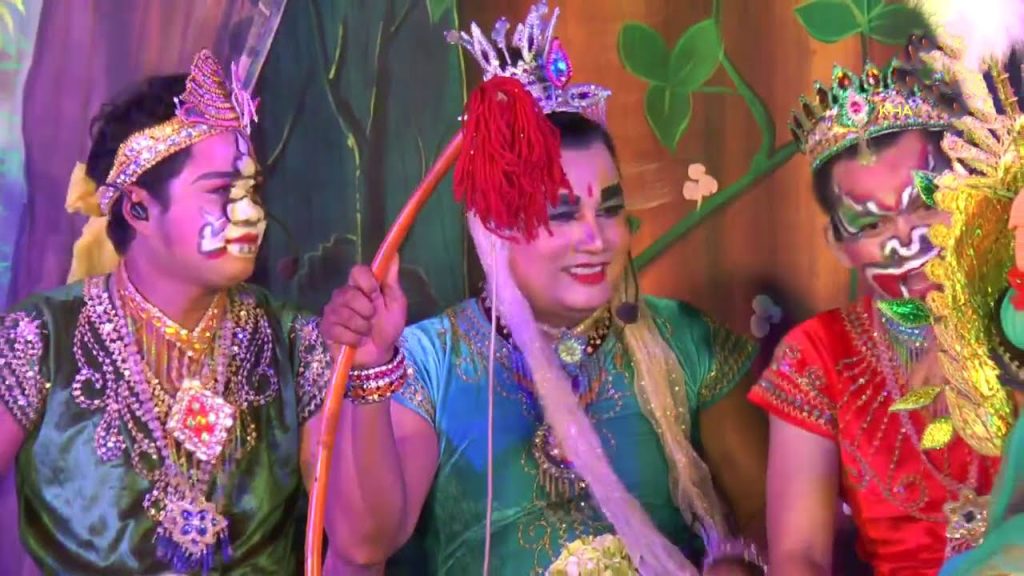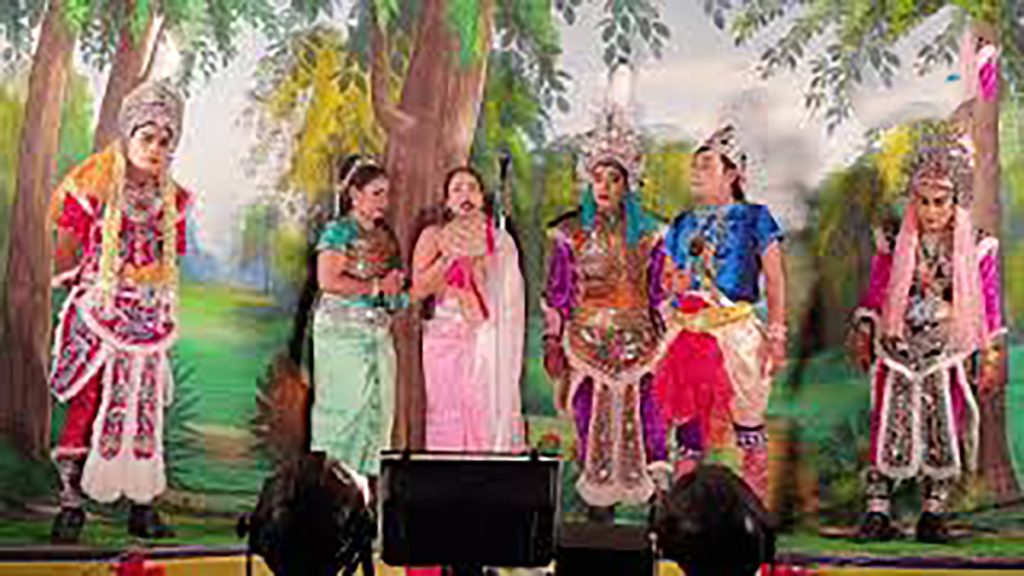ល្ខោនបាសាក់ ជាទម្រង់សិល្បៈទស្សនីយភាពមួយ ដែលមានប្រជាប្រិយភាពធំធេងណាស់នៅក្នុងស្រទាប់ទស្សនិកជនខ្មែរ។ ទម្រង់នេះមានវត្តមានរហូតមកដល់ឆ្នាំ១៩៥៣ ឬក្រោយនេះបន្តិច នៅតាមទីជនបទនានា ដូចជាខេត្តកណ្តាលឬតាមជាយក្រុងភ្នំពេញ ជាដើម។ ចំណែកឯប្រជាជនខ្មែរដែលរស់នៅភាគខាងក្រោម នៃប្រទេសកម្ពុជា គឺដែនដីកម្ពុជាក្រោមដែលបានក្លាយទៅជាដែនដីភាគខាងត្បូង នៃប្រទេសវៀតណាមនៅឆ្នាំ១៩៤៩ និយមហៅទម្រង់ល្ខោននេះថា «ល្ខោនយូរកេរ» ដែលមានន័យថា «មរតករបស់ខ្មែរ តាំងពីយូរលង់ណាស់មកហើយ»។
ក្នុងអំឡុងឆ្នាំ១៩២៩ ឬ ១៩៣០ ក្រោយពីពេលដែលពង្រីកពង្រឹងខ្លួនរឹងមាំហើយ ក្រុមសិល្បៈយូរកេរនៃស្រុកបាសាក់ដែលដឹកនាំដោយលោក ឆា គ្រួន (ឈ្មោះដើម លី សួន) បានធ្វើសកម្មភាពឡើងមកសម្តែងនៅបណ្តាខេត្តមួយចំនួនតាមដងទន្លេមេគង្គ និងរាជធានីភ្នំពេញ តាមទូកប៉ុកចាយជាមធ្យោបាយដឹកជញ្ជូន ស្នាក់នៅ និងកន្លែងសម្តែងខ្លះផង។
ទស្សនិកជននៅដំបន់កម្ពុជាកណ្តាល ជក់ចិត្តដិតអារម្មណ៍យ៉ាងខ្លាំងរហូតដល់នាំគ្នាហៅទម្រង់ល្ខោននេះថា «ល្ខោនបាសាក់» ដោយយកទីកន្លែងកំណើតនៃវង់សិល្បៈ មកដាក់ជាឈ្មោះទម្រង់តែម្តង រហូតមកទល់នឹងសព្វថ្ងៃនេះ។

ក្រោយពីសាកលវិទ្យាល័យភូមិន្ទវិចិត្រសិល្បៈ បានបង្កើតឡើងនៅឆ្នាំ១៩៦៥មក ទម្រង់ល្ខោនបាសាក់ក៏ដូចជាទម្រង់សិល្បៈឯទៀត ត្រូវបានបញ្ចូលទៅក្នុងកម្មវិធីសិក្សារបស់សកលវិទ្យាល័យ ដោយមានការចាត់ឱ្យគ្រូនិងសិស្សចុះទៅធ្វើការស្រាវជ្រាវ រៀនសូត្រពីគ្រូនិងសិល្បករជំនាញ ដូចជាលោកតា សាំង សារុន និង អ្នកស្រី ចេក ម៉ាច លោកគ្រូ ពៅ លោកគ្រូ ណន និងលោកគ្រូ សាមិត ជាដើម។ លើសពីនេះទៅទៀត សកលវិទ្យាល័យក៏បានអញ្ជើញលោកគ្រូ ទក ខ្មៅ ដែលមានទេពកោសល្យ ខ្ពស់លើតួឯក តួយក្ស និងតួត្លុក មកបង្រៀនសិស្សថែមទៀត។
វង់តន្ត្រីបាសាក់ រួមមានឧបករណ៍ទ្រអ៊ូ (ឧបករណ៍សំខាន់នាំមុខ) ឃឹមតូច ឃឹមធំ ខ្លុយ ប៉ាន់ ឡោ ឃ្មោះ និងស្គរ ដែលមានលក្ខណៈឥទ្ធិពលចិនច្រើន។ «ហួន» ជាលក្ខណៈពិសេស របស់ល្ខោនបាសាក់។ សឹងតែគ្រប់តួអង្គទាំងអស់ មានក្បាច់ហួន ប្រចាំតួរៀងៗខ្លួន ពោលគឺ ហួនប្រុស ហួនស្រី ហួនយក្ស ជាដើម។
ល្ខោនបាសាក់សម្តែងរឿងជាច្រើនរួមមាន ព្រះលក្សិណាវង្ស ព្រះច័ន្ទគោរព រតនាវង្ស ម៉ាក់ភូយុងកែវ និងស័ង្ខសិល្ប៍ជ័យ ជាដើម។ល។
រឿងស័ង្ខសិល្ប័ជ័យ
រឿងស័ង្ខសិល្ប៍ជ័យ ជារឿងបុរាណ ដែលគេទុកជាកម្រងស្នាដៃដ៏ល្បី និងមានកម្រិតខ្ពស់ក្នុងអក្សរសិល្ប៍ខ្មែរ។ ផ្ទាំងរឿងស័ង្ខសិល្ប៍ជ័យនេះ លាតត្រដាងពី ទំនាស់រវាងសភាវៈបណ្ឌិតនិងពាល។
កាលនោះ នគរបញ្ចបុរីមានទុរភឹកវឹកវរ ដោយមានយក្សយារយីចាប់ប្រជារាស្រ្ត ស៊ីរាល់ថ្ងៃ។ ព្រះចៅក្រុងបញ្ចបុរី មានមហេសីនិងបុត្រជាច្រើនអង្គ។ ថ្ងៃមួយយក្ស កុម័្ភណ្ឌ បានចាប់យកនាង កែវ សុមន្ទា ដែលជាអគ្គមហេសីនៃព្រះចៅក្រុងបញ្ចបុរី យកទៅធ្វើជាមហេសីរបស់ខ្លួន។ ព្រះចៅក្រុងបញ្ចបុរី មានសេចក្តីទោម្នាស់ កើតទុក្ខយ៉ាងខ្លាំងដោយព្រាត់ប្រាស់ពីនាង កែវ សុមន្ទា។
ថ្លែងពីមហេសីឯទៀត ដោយសេចក្តីច្រណែនឈ្នានីស មានសេចក្តីសោមនស្ស ត្រេកអរជាអនេគដែលនាង កែវ សុមន្ទា ត្រូវបានយក្ស កុម្ភ័ណ្ឌ ចាប់យកទៅបាត់នេះ។ ជាបន្ទាប់មក មហេសីយង់ឃ្នងទាំងនោះ បានចាក់រុកព្រះចៅក្រុងបញ្ចបុរី ឱ្យបំបោះបង់មហេសីមួយអង្គទៀត ដែលបានប្រសូតព្រះរាជបុត្រពីរអង្គ មួយអង្គជា គជសីហ៍ និងមួយអង្គទៀត ជាខ្យងស័ង្ខ ដោយចោទថាចង្រៃណាស់។ ដូច្នេះហើយ បានជានគរមានទុរភឹកវឹកវរ មានយក្សមកចាប់ប្រជារាស្រ្តស៊ីរាស់ថ្ងៃ។
ថ្លែងពីបុត្រពាលបួនអង្គ បានចូលមកគាល់ព្រះបិតា ហើយធានាថានឹងទៅរំដោះ ព្រះមាតុឆា ព្រះនាង កែវ សុមន្ទា ដែលកុម្ភ័ណ្ឌបានចាប់យកទៅនោះមកវិញ។ តាមការពិត បុត្រពាលទាំងបួនអង្គ មានកលល្បិចចង់សម្លាប់ប្អូនទាំងបី ដោយធ្វើរាជសារក្លែងក្លាយយកទៅឱ្យគជសីហ៍ ខ្យងស័ង្ខ និងស័ង្ខសិល្ប៍ជ័យ ថាជាព្រះរាជសារពីព្រះបិតាព្រះចៅក្រុងបញ្ចបុរី បញ្ជាឱ្យអ្នកទាំងបីទៅរំដោះ ព្រះមាតុឆាពីយក្សកុម្ភ័ណ្ឌទៅវិញ។

ដោយគ្មានក្តីងឿងឆ្ងល់ពីរាជសាររបស់ព្រះបិតា និងដោយគោរពតាមព្រះរាជ បញ្ជារបស់ព្រះបិតា គជសីហ៍ ខ្យងស័ង្ខ និងស័ង្ខសិល្ប៍ជ័យ ក៏នាំគ្នាចេញទៅ ស្វែងរកនិងរំដោះព្រះមាតុឆាពីកុម្ភ័ណ្ឌ។ តាមផ្លូវឆ្លងសមុទ្រ បុត្រពាលទាំងបួនអង្គ សុំឱ្យគជសីហ៍នៅជាមួយដើម្បីជួយថែរក្សាខ្លួនឯនាយសមុទ្រ។ ចំណែកឯ ស័ង្ខសិល្ប៍ជ័យ ក៏ជិះលើខ្យងស័ង្ខឆ្លងកាត់សមុទ្រទៅនគរកុម្ភ័ណ្ឌ តាមរកព្រះមាតុឆា នាង កែវ សុមន្ទា។ នានគរកុម័្ភណ្ឌ កុម័្ភណ្ឌបម្រុងនឹងលើកបុត្រី នាងសុពណ៌ទេវី ឱ្យទៅមហារាជ ស្តេចភុជង្គនាគ ក្នុងគោលបំណងចងស្ពានមេត្រីពង្រឹងមិត្តភាព។ នៅពេលដែលកុម្ភ័ណ្ឌ យកនាងសុភណ៌ទេវី ទៅថ្វាយមហារាជនាស្ថានភុជង្គនាគនោះ ស័ង្ខសិល្បជ័យនិង ខ្យងស័ង្ខ ក៏បានមកដល់នគរកុម័្ភណ្ឌ ហើយបានជួយនឹងនាង កែវ សុមន្ទា។ កុម័្ភណ្ឌ នៅពេលត្រឡប់មកដល់ព្រះនគរវិញ ក៏ត្រូវស័ង្ខសិល្ប៍ជ័យនិងខ្យងស័ង្ខ សម្លាប់ចោលទៅ៕
———————————–
THE STORY OF SAING SILACHEY IN THE BASAKK THEATER
The Basakk theater is a popular form of performing arts in Cambodia, particularly, among the masses. This theatrical form has had its presence in Cambodia up to 1953 or shortly thereafter in the rural areas, namely, the Kandal province and its vicinity. Whereas the Khmer population, living in low-land Cambodia—the present-day Kampuchea Kraom—has generally referred to this theater as “Youke theater,” meaning “Khmer heritage theater” ever since (Pich 2000: 38).
In 1929 or 1930, the Youke troupe of the Basakk region led by Mr. Chha Kruon (Ly Suon) had organized performing tours to perform in some provinces along the Mekong-river and the city capital of Phnom Penh by boat that served as transportation, dwelling quarter as well as performing stage (Pich 2003: 157).
The middle-land Khmer were very fond of this theater that it earned its name as the “Basakk theater,” referring to its original place where the theater was born, i.e., the Basakk region until the present.
Following the establishment of the Royal University of Fine Arts in 1965, the Basakk theater and other performing art-forms have been included in the university’s curricula. The University has required professors and artists to conduct research and study among the masters and specialized artists, namely, Mr. Saing Sarun and Mrs. Chek Mach, Mr. Peou, Mr. Nan, and Mr. Samith. Moreover, the University had also invited Master Tork Khmao, who highly specialized in the male principal role, demon, and clown to come and teach students.
The music ensemble that accompanies the Basakk theater includes tror ou chamhieng (Half coconut-shell two-stringed fiddle, leading instrument), khimm tauch (High-pitched dulcimer), khimm thomm (Low-pitched dulcimer), khloy (Duct flute), pann (woodblock), lo (Cymbal), khmuoh (flat gong), and drums.
“Huon” (movements, gestures, and postures) are special characteristics of the Basakk theater, specifically pertaining to particular roles: male, female, or demon. The Basakk theater is developed upon stories, such as Preak Leak Sinnavung, Preah Chann Korup, Ratana Vung, Makk Phouyung Keo, Saing Silachey, and so on.
Saing Silachey is a traditional story, among the literary masterworks, highly regarded by the Khmer. The story epitomizes social justice, leadership, power, the welfare of the people, and conflict between the learned and devil characters.
Once upon a time, Panhcha Burey was in turmoil. People experienced social injustice and abuse of power, while every day, the citizens of Panhcha Burey were abducted by demons.
The King of Panhcha Burey had several wives, concubines, and children. The King enjoyed his harem tremendously and often ignored and had little concern for the welfare of his people. One day, his unjust fate befell upon him. The demon King Kumphoan abducted the King’s own wife, Keo Sumantea. The King was very sad at the loss of his favorite wife. On the contrary, due to jealousy, the King’s other wives and concubines were very happy that Keo Sumantea was abducted by the demon.
As the story continued to unfold, one of the King’s wives gave birth to two sons, one having the head of an elephant and the other a snail. Taking the opportunity to harm the mother, the wicked wives asked the King to banish the mother and her unnaturally newborn children. The poor family was banished in the forest.
One day, four of the King’s evil sons came to pay respect to their father. They were told of the sad news of Keo Sumantea’s abduction by the demon. They assured the King the father that they would go and rescue Keo Sumantea. As a matter of fact, they were but coward. Consequently, they faked a letter and went to seek for their three younger brothers—Kuchasey, Khyang Saing, and Saing Silachey. After finding the trio, they presented them with the fake letter and told them that the King had asked them to go and rescue Keo Sumantea from the demon. With all the respect for their father, the trio accepted the order without a doubt. As tricky and coward as they were, the quartet asked Kuchasey to remain with them to protect them from intruders. Only Khyang Saing and Saing Silachey then set out in the search for Keo Sumantea.
In the meantime, with the demon King Kumphoan, Keo Sumantea had a beautiful daughter named Supoar Tevi. One day, Kumphoan intended to consolidate his force and strengthen his alliance with the King of the Naga, Moha Reach in the underworld. Kumphoan gave his beautiful daughter Supoar Tevi to Moha Reach as his wife.
While Kumphoan was away presenting Supoar Tevi to Moha Reach, Khyang Saing and Saing Silachey arrived at his kingdom and found Keo Sumantea. The duet asked Keo Sumantea to return to Panhcha Burey. Not for long, Kumphoan returned to his kingdom only to be slain by the duet, an act that brings the story to its end.
អត្ថបទដើម៖ បណ្ឌិត សំ សំអាង






